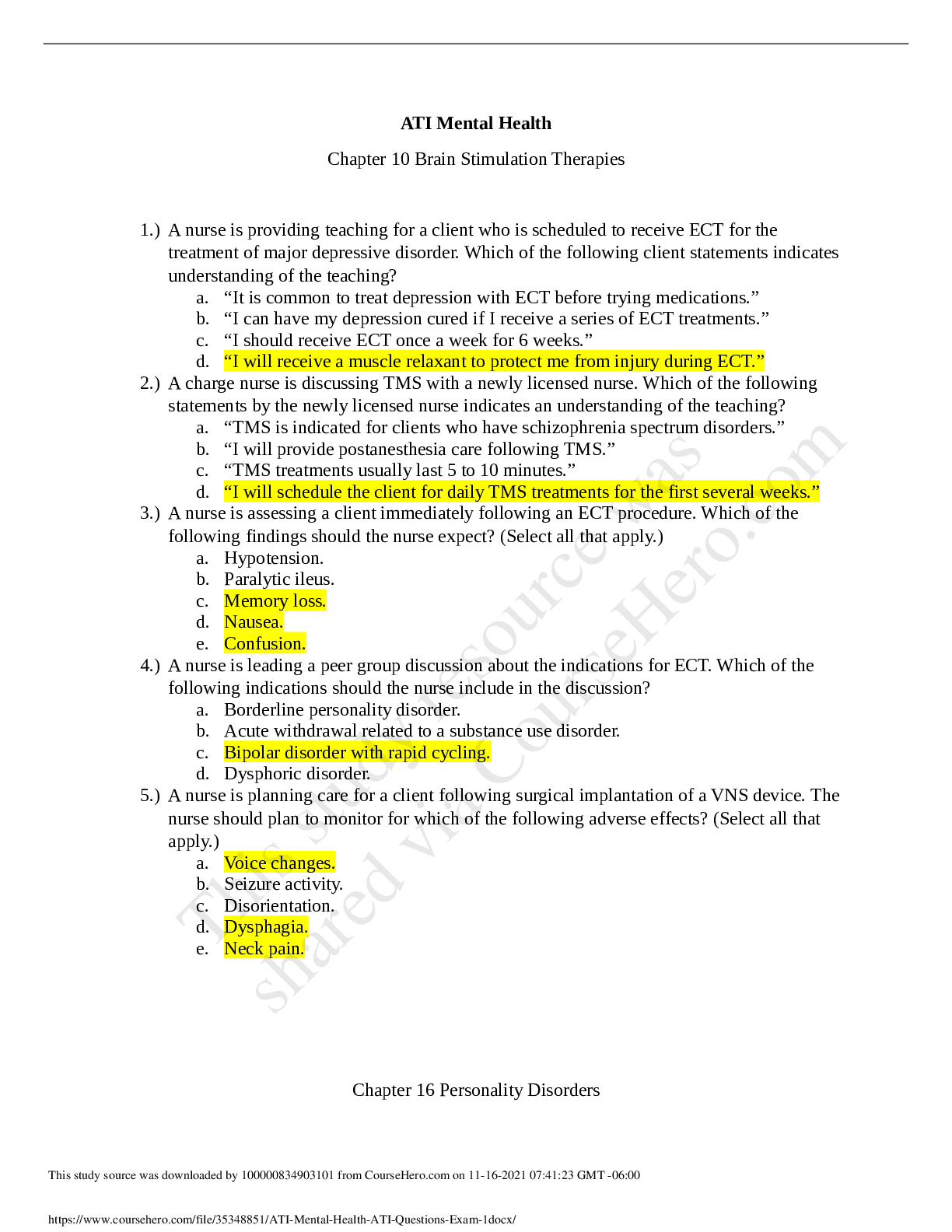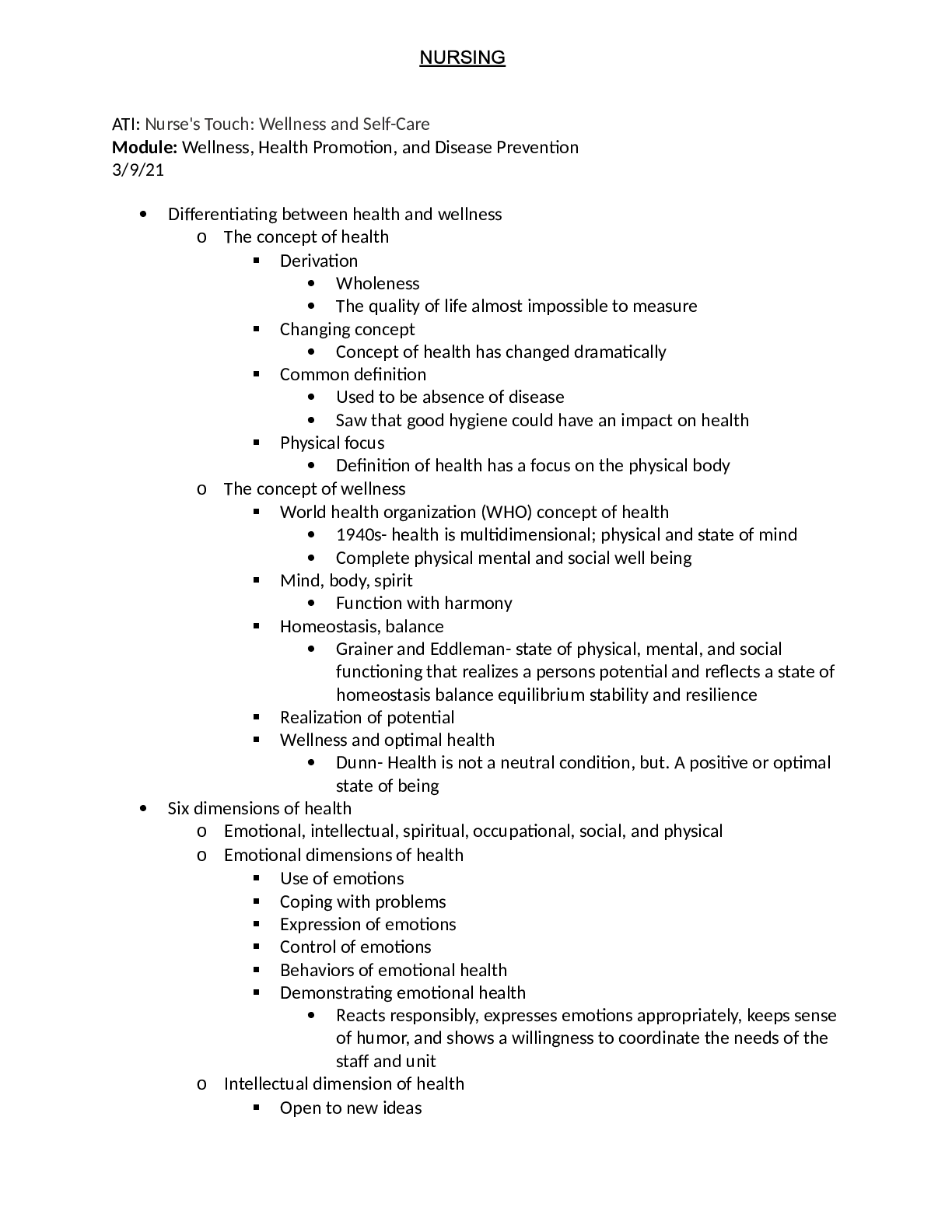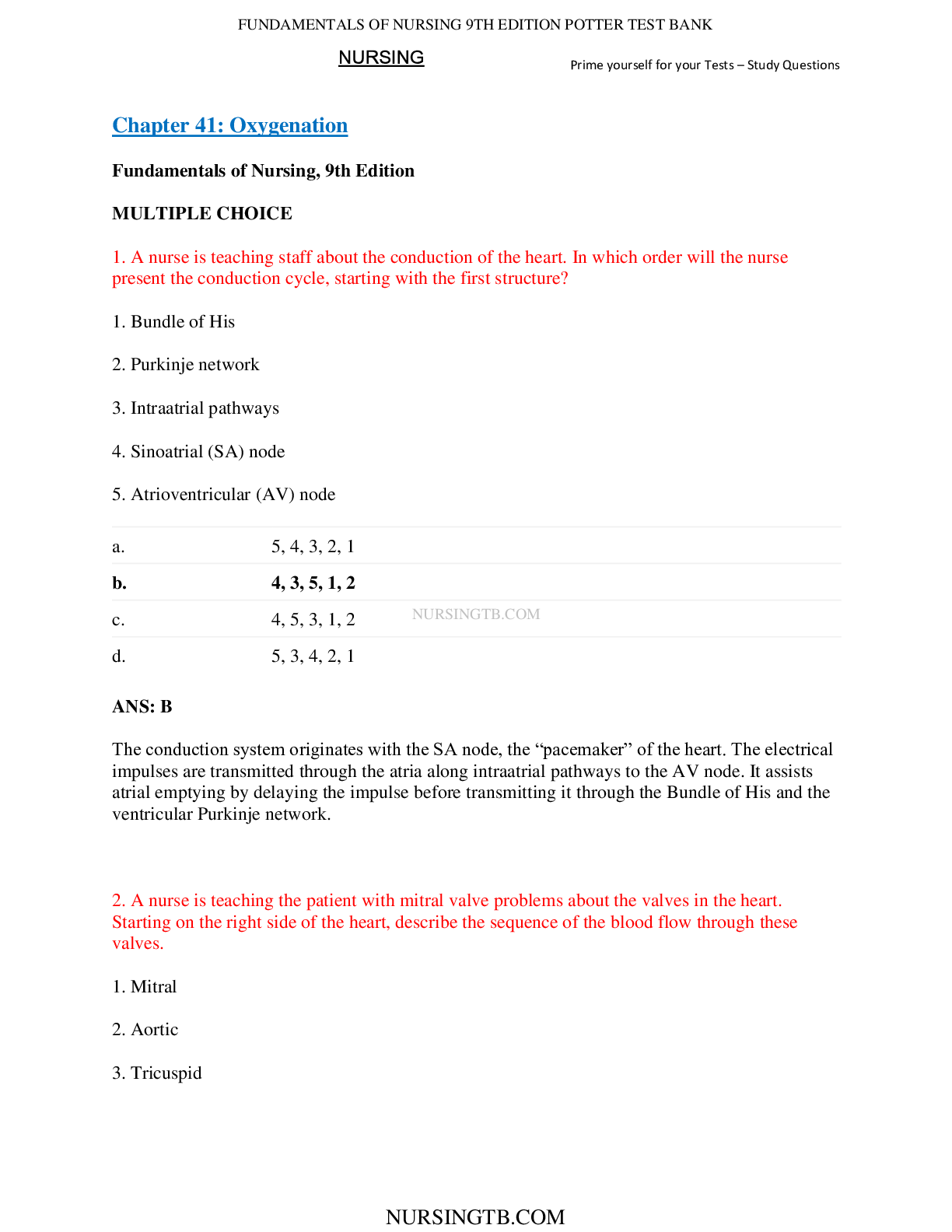Search for
Filter By
Rating
Price in $
Search Results 'Self'
Showing All results
Sort by
*NURSING > TEST BANK > Which of the following would be the most likely cause of an iatrogenic disease? a. An inherited disorder b. A combination of specific etiological factors c. An unwanted effect of a prescribed drug d. Prolonged exposure to toxic chemicals in the environment The manifestations of a disease are best defined as the: a. subjective feelings of discomfort during a chronic illness. b. signs and symptoms of a disease. c. factors that precipitate an acute episode of a chronic illness. d. early indicators of the prodromal stage of infection. The best definition of the term prognosis is the: a. precipitating factors causing an acute episode. b. number of remissions to be expected during the course of a chronic illness. c. predicted outcome or likelihood of recovery from a specific disease. d. exacerbations occurring during chronic illness Which of the following is considered a systemic sign of disease? a. Swelling of the knee b. Fever c. Pain in the neck d. Red rash on the face Etiology is defined as the study of the: a. causes of a disease. b. course of a disease. c. expected complications of a disease. d. manifestations of a disease. A type of cellular adaptation in which there is a decrease in cell size is referred to as: a. hypertrophy. b. metaplasia. c. anaplasia. d. atrophy. A change in a tissue marked by cells that vary in size and shape and show increased mitotic figures would be called: a. metaplasia. b. atrophy. c. dysplasia. d. hypertrophy. A deficit of oxygen in the cells usually due to respiratory or circulatory problems is called: a. apoptosis. b. ischemia. c. hypertrophy. d. necrosis. When a group of cells in the body dies, the change is called: a. ischemia. b. gangrene. c. hypoxia. d. necrosis. Rigorous weight lifting/body building regimens may result in the skeletal muscle cells undergoing: a. hypertrophy. b. dysplasia. c. atrophy. d. regeneration. The term cancer refers to: a. dysplasia. b. hyperplasia. c. metaplasia. d. malignant neoplasm. To which of the following does the term apoptosis refer? a. Increased rate of mitosis by certain cells b. Ischemic damage to cells c. Liquefaction of necrotic tissue d. Preprogrammed cell self-destruction Which of the following statements is TRUE? a. Alteration of DNA does not change cell function. b. Damaged cells may be able to repair themselves. c. All types of cells die at the same rate. d. Mild ischemia causes immediate cell death. Caseation necrosis refers to an area where: a. cell proteins have been denatured. b. cell are liquefied by enzymes. c. dead cells form a thick cheesy substance. d. bacterial invasion has occurred. Routine application of sun block to skin would be an example of: a. an iatrogenic cause of cancer. b. a preventive measure. c. a precipitating factor. d. a predisposing condition. A circumstance that causes a sudden acute episode of a chronic disease to occur is termed
*NURSING > TEST BANK > TEST BANK FOR PSYCHIATRIC MENTAL HEALTH NURSING 6TH EDITION BY VIDEBECK Link download test bank full: https://digitalcontentmarket.org/download/test-bank-for-psychiatric-mental-healthnursing-6th-edition-by-videbeck Link download solution manual full: https://digitalcontentmarket.org/download/solution-manual-for-psychiatric-mental -health-nursing-6th-edition-by-videbeck/ 1. The nurse is assessing the factors contributing to the well-being of a newly admitted client. Which of the following would the nurse identify as having a positive impact on the individual's mental health? A) Not needing others for companionship B) The ability to effectively manage stress C) A family history of mental illness D) Striving for total self-reliance Ans B Feedback: Individual factors influencing mental health include biologic makeup, autonomy, independence, self-esteem, capacity for growth, vitality, ability to find meaning in life, emotional resilience or hardiness, sense of belonging, reality orientation, and coping or stress management abilities. Interpersonal factors such as intimacy and a balance of separateness and connectedness are both needed for good mental health, and therefore a healthy person would need others for companionship. A family history of mental illness could relate to the biologic makeup of an individual, which may have a negative impact on an individual's mental health, as well as a negative impact on an individual's interpersonal and social–cultural factors of health. Total self-reliance is not possible, and a positive social/cultural factor is access to adequate resources
*NURSING > TEST BANK > Maternity and Pediatric Nursing - Third Edition > all chapters questions and answers / Prime yourself for your Tests – Study Questions
*NURSING > TEST BANK > ATI: Nurse's Touch: Wellness and Self-Care > Module: Wellness, Health Promotion, and Disease Prevention
Engineering > TEST BANK > David Atkinson, Mahouton Norbert Hounkonnou, Porter Wear Johnson - Exercises in Quantum Mechanics_ A Self-Contained Book of Questions and Answers-Rinton Press (2003).pdf
*NURSING > TEST BANK > Leadership Final : Managing Self: Stress and Time Yoder-Wise: Leading and Managing in Nursing, 7th Edition
*NURSING > TEST BANK > NU 136 Fundamentals of Nursing 9th Edition Potter Test Bank- Prime yourself for your Tests Study Questions and Answers
*NURSING > TEST BANK > NU 136 Fundamentals of Nursing 9th Edition Potter Test Bank- Prime yourself for your Tests Study Questions and Answers
*NURSING > TEST BANK > Maternity and Pediatric Nursing - Third Edition > all chapters questions and answers / Prime yourself for your Tests – Study Questions




.png)




